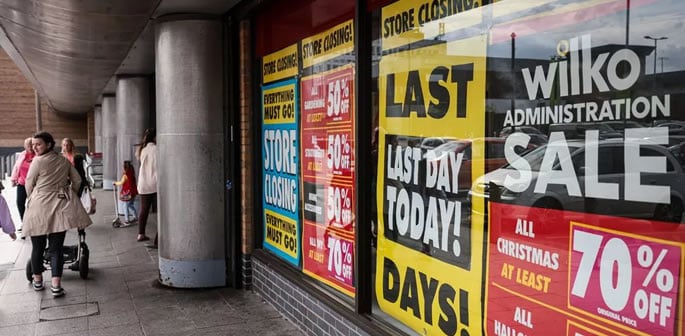"we haven't been able to make a small number of them work"
The UK high street continues to decline as Poundland shut down nine former Wilko locations just months after bringing them back to life.
Around 71 Wilko stores were bought by Poundland after the former fell into administration in 2023.
But since then, a number of stores have closed down including locations in Alfreton, Bishop’s Stortford and Ellesmere Port.
A spokesperson for Poundland said that the retailer had “moved really quickly” to open a significant number of stores so that they could offer roles for staff.
They added: “While it’s disappointing we haven’t been able to make a small number of them work in the long term, all the people employed at those stores have been offered roles at nearby locations.”
In recent years, the high street has gone from bustling to deserted as more stores close their doors for good.
This is partially due to the Covid-19 pandemic, with retailers feeling the financial squeeze.
High energy costs and business rates have hit retailers, resulting in many being forced to close stores as they can no longer operate within their budgets.
On the other side, shoppers have been cutting back on spending due to the rising cost of living crisis.
More shoppers have also been turning to online retail.
In 2023, Argos announced plans to close 100 standalone UK branches as it looks to move away from the high street and focus on expanding its presence in supermarkets.
Meanwhile, B&Q has over 300 shops across the UK. But in recent months, some stores have closed.
Boots announced it would be closing 300 stores over the next year as part of plans to evolve its brand.
Closures are ongoing and this will see the retailer’s estate reduced from 2,200 to 1,900 shops.
It has been worse for The Body Shop as it fell into administration. As of the end of April 2024, 82 branches have shut.
Outdoor clothing brand Trespass announced in July 2023 that it was closing six branches. More stores are expected to close.
WHSmith has over 1,100 stores across the UK. But since March 2023, eight stores have closed down and more are on the way.
For the most part, supermarkets have braved the storm as they provide essential items like food and drink.
But not all food retailers have been fortunate.
Frozen foods chain Iceland has more than 900 stores nationwide.
However, nearly two dozen stores closed for good in 2023. More have shut in 2024 and others have been earmarked for closure.
This is a similar case for Lidl.
The supermarket, which has 950 stores, is changing up shop locations.
This has meant that some stores will have to close but the supermarket brand is also looking to open 12 new branches.
M&S, which has 405 stores across the UK, has been closing several branches, which is a blow for shoppers.
It’s not all bad news, though, because the chain also has big plans to open dozens of new shops as well.
The decline of the UK high street is a complex interplay of various factors.
Economic shifts, changing consumer behaviour, the rise of online shopping and the impact of global events like the pandemic have all contributed to this trend.
However, amidst the challenges lie opportunities for innovation, adaptation and the creation of new retail experiences that blend the physical and digital realms.





























































